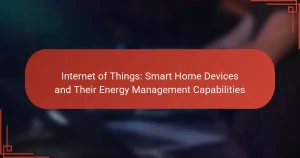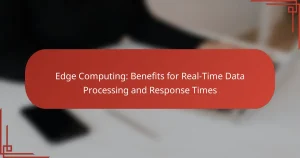Renewable energy technology encompasses solar, wind, hydro, geothermal, and biomass energy sources that are naturally replenished. This technology aims to reduce reliance on fossil fuels and lower greenhouse gas emissions, with renewable energy comprising nearly 30% of global electricity generation in 2020. Key advancements include enhanced battery technologies, such as lithium-ion and solid-state batteries, which improve energy storage efficiency and management through artificial intelligence. Future trends indicate significant growth in solar power efficiency and storage solutions, with expectations for the global renewable energy market to reach $1.5 trillion by 2025.
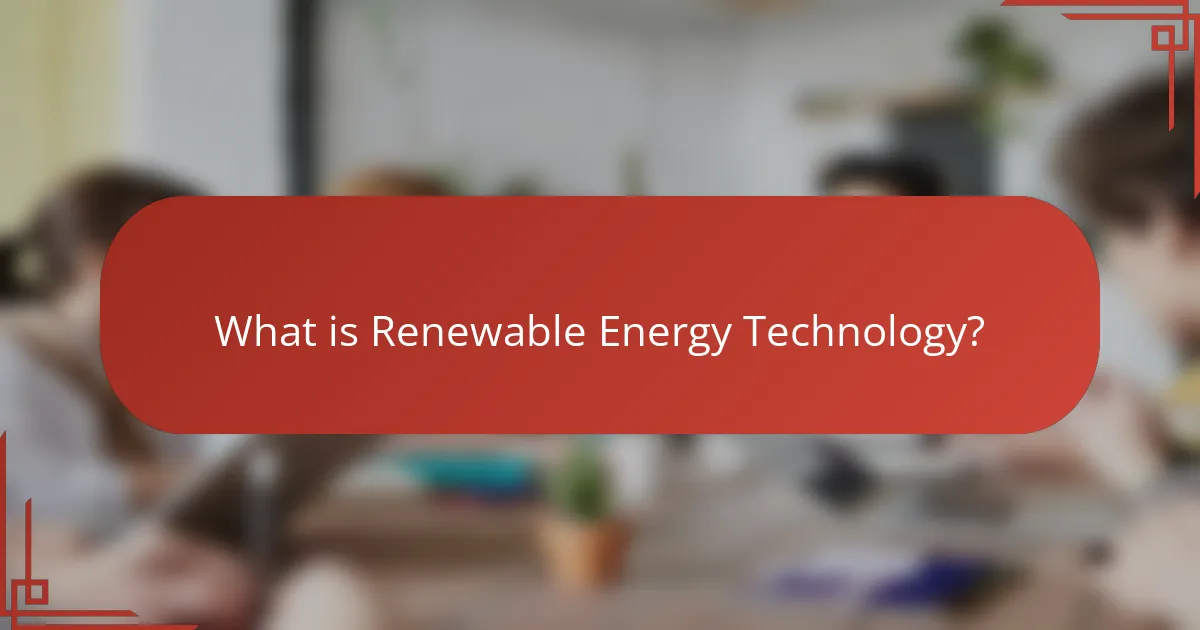
What is Renewable Energy Technology?
Renewable energy technology refers to the use of resources that are naturally replenished. This includes solar, wind, hydro, geothermal, and biomass energy sources. These technologies harness energy from the sun, wind, water, and organic materials. They are designed to reduce dependency on fossil fuels. Renewable energy technologies help decrease greenhouse gas emissions. According to the International Energy Agency, renewable energy accounted for nearly 30% of global electricity generation in 2020. This demonstrates the growing importance of these technologies in the energy sector.
How does Renewable Energy Technology contribute to sustainability?
Renewable energy technology contributes to sustainability by reducing greenhouse gas emissions. It harnesses natural resources like sunlight, wind, and water. These resources are abundant and renewable, unlike fossil fuels. For example, solar panels convert sunlight into electricity without emitting carbon dioxide. Wind turbines generate power without air pollutants. According to the International Renewable Energy Agency, renewable energy could reduce global CO2 emissions by up to 70% by 2050. This shift helps mitigate climate change impacts. Additionally, renewable energy technologies promote energy independence. They reduce reliance on imported fuels, enhancing energy security. Adopting these technologies fosters sustainable economic growth through job creation in green sectors.
What are the different forms of Renewable Energy Technology?
The different forms of renewable energy technology include solar, wind, hydroelectric, geothermal, and biomass energy. Solar energy technology harnesses sunlight using photovoltaic cells or solar thermal systems. Wind energy technology utilizes turbines to convert wind kinetic energy into electricity. Hydroelectric technology generates power through the flow of water in rivers or dams. Geothermal energy technology extracts heat from the Earth’s interior for electricity or heating. Biomass energy technology converts organic materials into fuel or electricity. These technologies are essential for reducing reliance on fossil fuels and mitigating climate change.
How does Renewable Energy Technology impact the environment?
Renewable energy technology positively impacts the environment by reducing greenhouse gas emissions. It replaces fossil fuels with cleaner energy sources like solar, wind, and hydro. For instance, solar power systems can reduce carbon dioxide emissions by approximately 90% compared to coal power. Additionally, renewable energy technologies contribute to lower air pollution levels. This results in improved public health and reduced healthcare costs. Renewable energy also conserves water compared to traditional energy sources. For example, solar photovoltaic systems require minimal water for operation. Overall, the adoption of renewable energy technologies fosters a sustainable environment.
What is the role of solar power in Renewable Energy Technology?
Solar power is a crucial component of renewable energy technology. It harnesses sunlight to generate electricity, providing a clean and sustainable energy source. Solar power systems convert solar radiation into usable energy through photovoltaic cells or solar thermal systems. In 2022, solar energy accounted for approximately 20% of global electricity generation, demonstrating its growing importance. The technology reduces reliance on fossil fuels and lowers greenhouse gas emissions. Additionally, advancements in solar efficiency and energy storage solutions enhance its viability. Innovations continue to improve solar panel efficiency, making it a leading option in renewable energy.
How does solar power generation work?
Solar power generation works by converting sunlight into electricity. Photovoltaic (PV) cells within solar panels absorb sunlight. This absorbed light energizes electrons in the cells, causing them to move. The movement of these electrons generates direct current (DC) electricity. An inverter then converts DC electricity to alternating current (AC) electricity, suitable for home use. Solar panels can produce electricity even on cloudy days, though efficiency decreases. According to the U.S. Department of Energy, solar energy accounted for about 3% of total U.S. electricity generation in 2020, demonstrating its growing role in renewable energy.
What are the key components of solar power systems?
The key components of solar power systems include solar panels, inverters, batteries, and charge controllers. Solar panels convert sunlight into electricity through photovoltaic cells. Inverters transform the direct current (DC) produced by solar panels into alternating current (AC) for household use. Batteries store excess energy generated for later use, enhancing energy availability. Charge controllers regulate the voltage and current coming from the solar panels to prevent battery overcharging. Together, these components enable efficient energy generation, storage, and consumption in solar power systems.
What innovations are driving solar power efficiency?
Innovations driving solar power efficiency include bifacial solar panels, perovskite solar cells, and improved tracking systems. Bifacial panels capture sunlight on both sides, increasing energy generation by up to 30%. Perovskite solar cells offer higher efficiency rates at a lower cost compared to traditional silicon cells. Advanced tracking systems adjust the panel angle throughout the day, maximizing sunlight exposure. Additionally, energy storage solutions like lithium-ion batteries enhance solar energy utilization by storing excess power for later use. These innovations collectively contribute to more effective and economical solar energy systems.
How do advancements in photovoltaic materials enhance efficiency?
Advancements in photovoltaic materials enhance efficiency by increasing light absorption and reducing energy loss. New materials like perovskites have superior light absorption capabilities compared to traditional silicon. This allows for more sunlight to be converted into electricity. Additionally, innovations in tandem solar cells combine different materials to capture a broader spectrum of sunlight. These combinations can improve overall energy conversion rates significantly. Research shows that perovskite-silicon tandem cells can achieve efficiencies over 30%. Such advancements also focus on reducing defects in materials, which minimizes energy loss during conversion. Enhanced manufacturing techniques further contribute to higher quality materials, leading to better performance in real-world conditions.
What are the latest technologies improving solar panel performance?
Recent advancements in solar panel technology include bifacial solar panels, which capture sunlight on both sides. This design can increase energy generation by up to 30% compared to traditional panels. Another innovation is the use of perovskite solar cells. These cells offer higher efficiency rates and lower production costs. Additionally, tracking systems have been developed to adjust the panel’s angle throughout the day, maximizing sunlight exposure.
Moreover, transparent solar panels are emerging, allowing for integration into windows without obstructing views. Energy storage technologies, such as lithium-ion batteries, are also improving. They enable better management of solar energy, allowing for use during non-sunny periods. According to the National Renewable Energy Laboratory, these technologies collectively enhance the overall efficiency and effectiveness of solar energy systems.
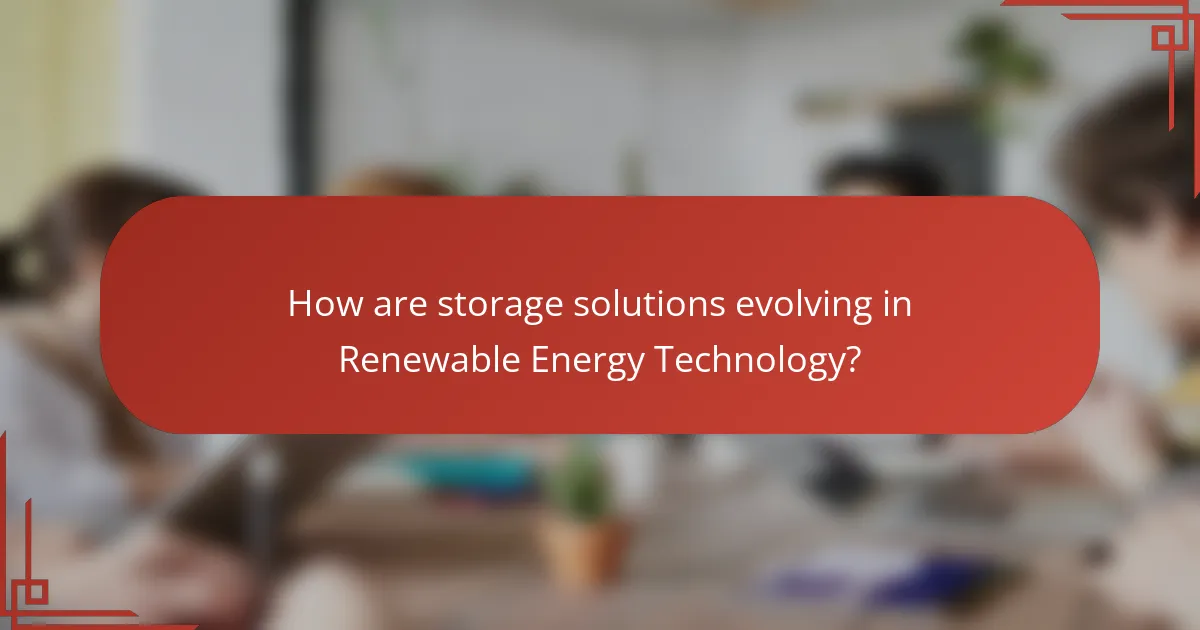
How are storage solutions evolving in Renewable Energy Technology?
Storage solutions in renewable energy technology are evolving through advancements in battery technology, improved energy management systems, and innovative materials. Battery technologies, such as lithium-ion and solid-state batteries, are becoming more efficient and cost-effective. This evolution enhances energy density and reduces charging times. Energy management systems are integrating artificial intelligence to optimize energy storage and distribution. These systems improve grid reliability and efficiency. Additionally, new materials like graphene are being researched for their potential to increase battery performance. According to the International Energy Agency, global battery storage capacity could reach 200 GWh by 2025, showcasing rapid growth in this sector.
What types of energy storage solutions are available for solar power?
The types of energy storage solutions available for solar power include lithium-ion batteries, lead-acid batteries, flow batteries, and pumped hydro storage. Lithium-ion batteries are the most common choice for residential solar systems due to their high efficiency and decreasing costs. Lead-acid batteries are a traditional option, often used for off-grid solar applications, but they have a shorter lifespan. Flow batteries offer scalability and long-duration storage, making them suitable for larger solar installations. Pumped hydro storage is a well-established method that uses water reservoirs to store energy and is effective for large-scale applications. Each solution has unique characteristics that cater to different energy needs and applications.
How do batteries function in solar energy storage?
Batteries function in solar energy storage by storing excess electricity generated from solar panels. When solar panels produce more energy than needed, batteries capture this surplus. The stored energy can be used later when solar generation is low or demand is high. Batteries typically use lithium-ion or lead-acid technology for efficient storage.
During the day, solar panels convert sunlight into electricity. This electricity can charge the batteries, allowing them to store energy. When the sun sets or during cloudy days, the batteries discharge stored energy to power homes or businesses.
According to the U.S. Department of Energy, battery storage systems can significantly enhance the reliability and efficiency of solar energy systems. By integrating batteries, users can maximize the use of solar energy and reduce reliance on the grid.
What alternative storage technologies are emerging?
Emerging alternative storage technologies include solid-state batteries, flow batteries, and hydrogen storage. Solid-state batteries utilize a solid electrolyte, offering higher energy densities and improved safety. Flow batteries store energy in liquid electrolytes, enabling scalability for large applications. Hydrogen storage involves converting excess renewable energy into hydrogen, which can be stored and used later for power generation. These technologies address limitations of traditional lithium-ion batteries, such as energy density, cycle life, and safety concerns. The International Energy Agency reports that these innovations are crucial for enhancing renewable energy integration into the grid.
Why is energy storage crucial for solar power systems?
Energy storage is crucial for solar power systems because it allows for the efficient management of electricity generated during peak sunlight hours. Solar panels produce energy only when the sun is shining. This creates a mismatch between energy production and consumption. Energy storage systems, like batteries, capture excess energy for later use. This ensures a steady power supply even when solar generation is low, such as at night or on cloudy days. According to the U.S. Department of Energy, energy storage can increase the reliability and resilience of solar power systems. It also helps to reduce reliance on fossil fuels during peak demand periods.
How does energy storage improve grid reliability?
Energy storage improves grid reliability by providing backup power during outages and balancing supply and demand. It allows excess energy generated during peak production times to be stored and used when demand is high. This capability reduces the risk of blackouts and stabilizes the grid. Energy storage systems, such as batteries, can respond quickly to fluctuations in energy demand. According to the U.S. Department of Energy, energy storage can enhance grid resilience by ensuring a continuous power supply. Additionally, it supports the integration of renewable energy sources, which can be intermittent. By smoothing out the variability of generation, energy storage contributes to a more reliable electricity supply.
What role does energy storage play in optimizing solar energy use?
Energy storage plays a crucial role in optimizing solar energy use. It allows for the capture of excess energy generated during peak sunlight hours. This stored energy can be used during periods of low sunlight or high energy demand. Energy storage systems, such as batteries, enhance grid stability and reliability. They enable a more consistent power supply, reducing reliance on fossil fuels. According to the U.S. Department of Energy, energy storage can increase solar energy utilization by up to 30%. This capability supports the transition to renewable energy sources and lowers overall energy costs.
What challenges do solar power and storage solutions face?
Solar power and storage solutions face several significant challenges. One major challenge is the intermittency of solar energy. Solar power generation is dependent on sunlight, which varies throughout the day and is affected by weather conditions. This variability can lead to inconsistent energy supply.
Another challenge is the high cost of storage technologies. Battery systems, such as lithium-ion batteries, can be expensive to install and maintain. The initial investment can deter widespread adoption despite their potential benefits.
Additionally, there are limitations in energy storage capacity. Current technologies may not store enough energy to meet demand during peak usage times or extended cloudy periods. This can create gaps in energy availability.
Furthermore, the recycling and disposal of solar panels and batteries pose environmental concerns. As solar installations increase, managing waste and ensuring sustainable practices become critical issues.
Regulatory and policy barriers also hinder the growth of solar power and storage solutions. Inconsistent regulations across regions can complicate deployment and investment in these technologies.
How do cost and efficiency factors impact solar technology adoption?
Cost and efficiency factors significantly impact solar technology adoption. Lower costs make solar systems more accessible to consumers and businesses. For example, the cost of solar panels has decreased by over 80% since 2010. Increased efficiency of solar panels leads to higher energy output per square meter. This efficiency improvement, often exceeding 20% in modern panels, enhances the return on investment. Consumers are more likely to adopt solar technology when financial incentives, like tax credits, are available. Additionally, financing options reduce the upfront costs, making solar more appealing. Overall, both cost and efficiency are critical in driving the market growth of solar technology.
What regulatory challenges affect the deployment of solar storage solutions?
Regulatory challenges affecting the deployment of solar storage solutions include inconsistent policies and interconnection standards. Different states and regions have varying regulations that can complicate implementation. These discrepancies can lead to confusion among stakeholders and hinder investment. Additionally, permitting processes can be lengthy and cumbersome, delaying project timelines. Financial incentives may also differ, affecting the economic viability of solar storage projects. Utility regulations can limit the ability to sell stored energy back to the grid. Furthermore, safety and performance standards are not universally defined, creating barriers for manufacturers. Overall, these regulatory hurdles can significantly impede the growth of solar storage technologies.
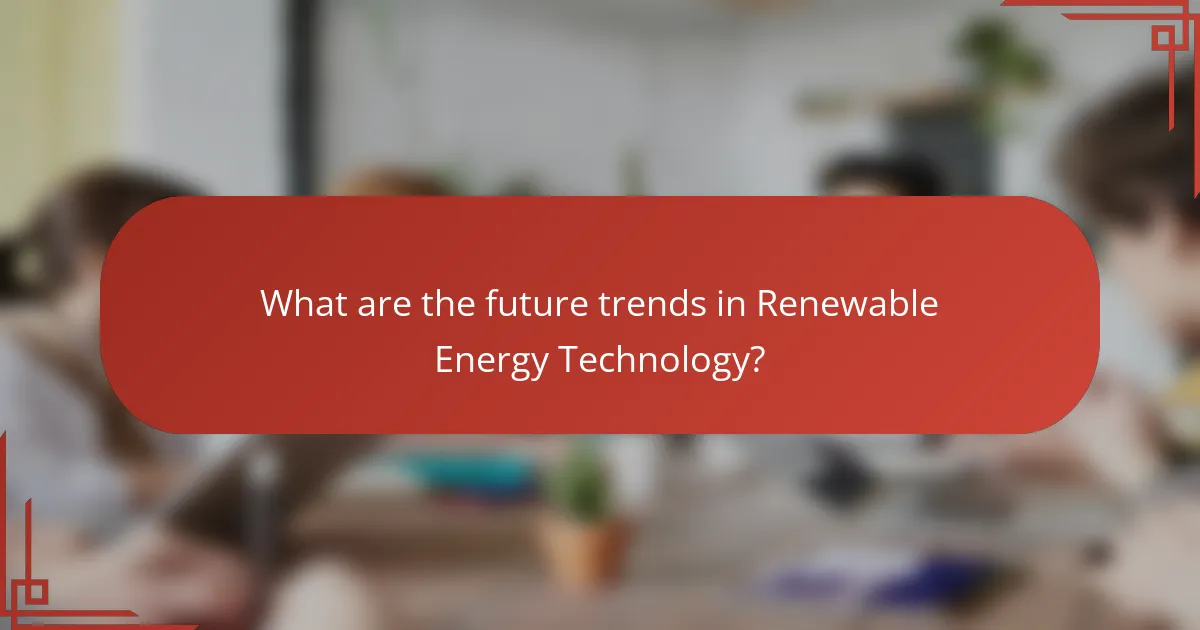
What are the future trends in Renewable Energy Technology?
Future trends in renewable energy technology include advancements in solar power efficiency and energy storage solutions. Solar panels are expected to become more efficient, with research suggesting efficiencies could exceed 30% in the coming years. Innovations in bifacial solar panels allow for increased energy capture from both sides. Energy storage technologies, such as lithium-sulfur batteries, are projected to enhance storage capacity and reduce costs. Additionally, the integration of artificial intelligence will optimize energy management systems. The global renewable energy market is anticipated to grow significantly, reaching $1.5 trillion by 2025. These trends indicate a shift towards more sustainable and efficient energy solutions.
How is the integration of AI influencing solar power efficiency?
The integration of AI is significantly enhancing solar power efficiency. AI algorithms optimize energy production by predicting solar irradiance and weather patterns. They analyze historical data to improve the performance of solar panels. For instance, machine learning models can forecast energy output with over 90% accuracy. AI also enables real-time monitoring of solar systems. This allows for immediate adjustments to maximize energy capture. Moreover, AI-driven predictive maintenance reduces downtime by identifying potential failures early. Studies show that AI can increase solar energy generation by up to 20%. These advancements demonstrate the transformative impact of AI on solar power efficiency.
What smart technologies are being developed for energy management?
Smart technologies for energy management include advanced energy management systems, smart meters, and IoT devices. Energy management systems optimize energy usage through data analytics. Smart meters provide real-time data on energy consumption. IoT devices enable remote monitoring and control of energy systems. These technologies enhance efficiency and reduce costs. According to a report by ResearchAndMarkets, the global smart energy management market is expected to grow significantly. This growth is driven by increasing demand for energy efficiency and sustainability.
What best practices should be followed for implementing solar power solutions?
Best practices for implementing solar power solutions include conducting a thorough site assessment, selecting high-quality solar panels, and ensuring proper installation. A site assessment evaluates sunlight exposure, shading, and roof condition. High-quality solar panels typically have higher efficiency rates and longer warranties. Proper installation involves adhering to local regulations and using certified professionals. Regular maintenance checks are essential to optimize performance and longevity. Additionally, integrating energy storage systems can enhance energy reliability and efficiency. These practices collectively lead to increased energy production and reduced operational costs.
How can users maximize the efficiency of their solar energy systems?
Users can maximize the efficiency of their solar energy systems by optimizing their panel placement and angle. Proper orientation towards the sun increases energy capture. Regular cleaning of solar panels removes dirt and debris that block sunlight. Monitoring energy production helps identify performance issues. Upgrading to high-efficiency solar panels can enhance overall output. Installing a solar battery storage system allows users to store excess energy for later use. Utilizing smart energy management systems can optimize energy consumption patterns. Research shows that these strategies can improve solar system efficiency by up to 30%.
What maintenance tips are essential for solar power systems?
Regular cleaning of solar panels is essential for optimal performance. Dust, dirt, and debris can block sunlight and reduce efficiency. Inspecting the system for any signs of damage is crucial. Look for cracks in panels or loose wiring. Monitoring the inverter’s performance ensures the system operates effectively. A drop in energy production may indicate an issue. Checking for shading from nearby trees or structures is also important. Trim any overhanging branches that may obstruct sunlight. Lastly, scheduling professional maintenance annually can help identify and resolve issues early. Regular maintenance can extend the lifespan of solar power systems significantly.
Renewable energy technology refers to the use of naturally replenished resources such as solar, wind, hydro, geothermal, and biomass energy. This article explores the advancements in solar power efficiency and energy storage solutions, highlighting the role of innovations like bifacial solar panels, perovskite solar cells, and AI integration. It addresses the environmental impact of renewable energy technologies, their contribution to sustainability, and the various forms of energy storage available for solar power systems. Additionally, the article discusses the challenges and future trends within the renewable energy sector, emphasizing the importance of energy management and best practices for optimizing solar energy systems.
